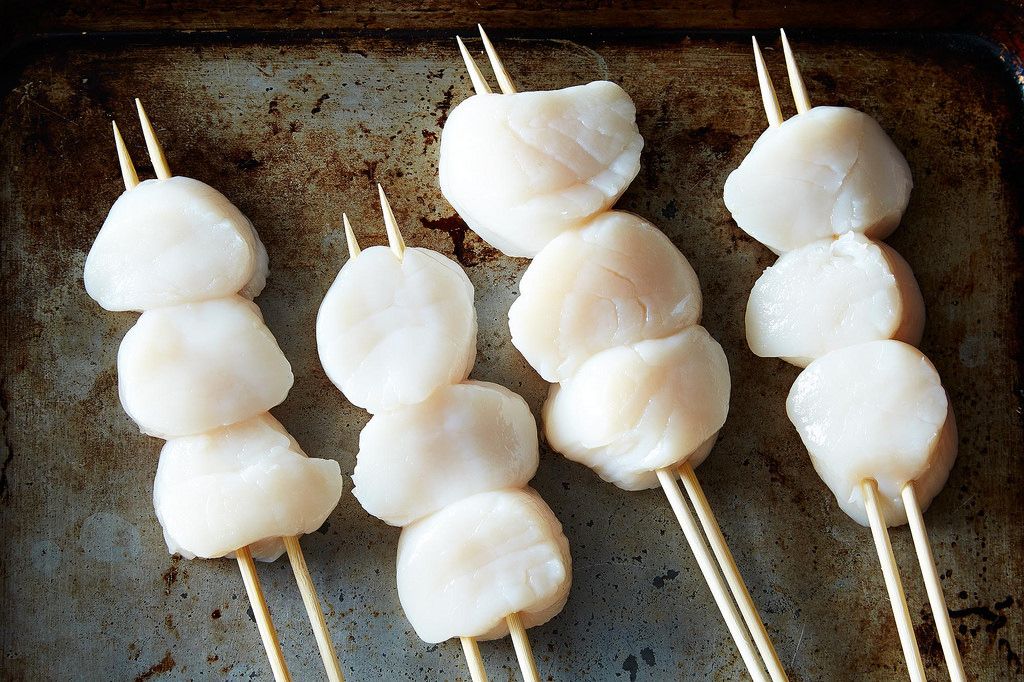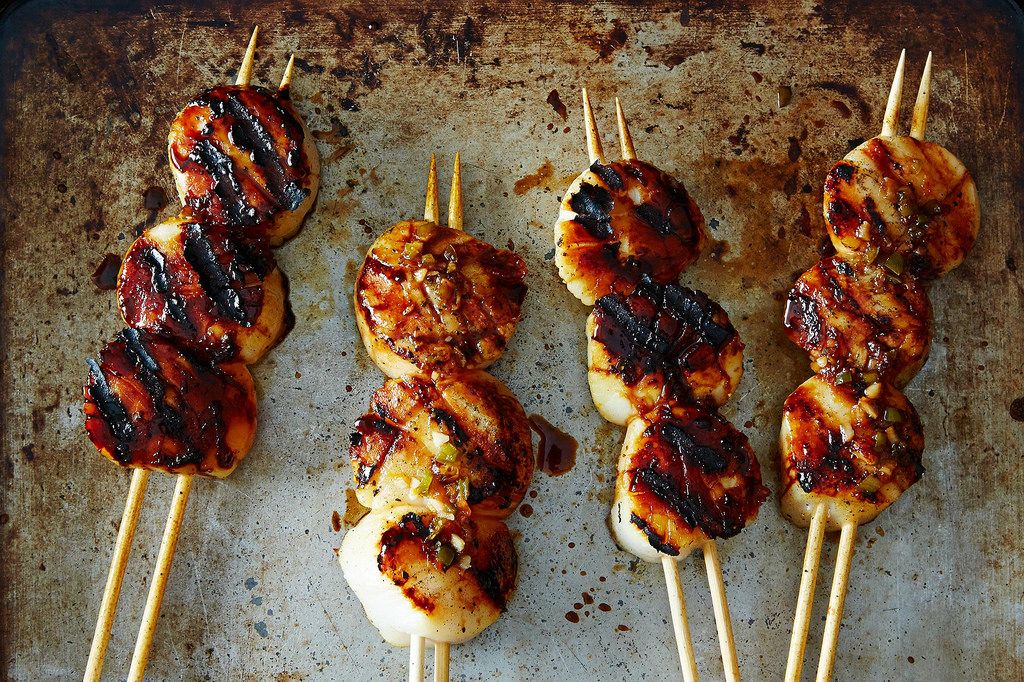The best grilled scallops are crisp on the outside and tender on the inside—perfect to plunk on top of arugula salad, buttered spaghetti, creamy risotto, you name it, or served alongside everything from potato salad to charred corn. The worst grilled scallops, meanwhile, are overcooked and rubbery and not at all what we want.
To help you reach Peak Scallop Perfection (it's out there!), we called in food writer and classically trained cook Christine Burns Rudalevige, who shares her top nine cooking tips below—plus, a ruby red grapefruit and chile glaze that the scallops totally love. (Psst: They also love an extra-cold rosé to go with.) And for even more A+ grilling recipes, tips, and tricks, check out our book Any Night Grilling by Paula Disbrowe. Now, fire up the grill and let's get started.
I recently saw a bumper sticker on a Subaru with Maine plates that read “Real friends visit in March.”
Thankfully, I have several of those types of friends. But I am also grateful for the many more who visit in the summer. These fair weather comrades typically want two things: to go to the beach, and to eat as much seafood as possible.
In the two years we’ve lived in coastal Maine, scallops have become my après beach summer seafood of choice. They are elegant, easy, and tailor-made for the grill. Because scallops are a bit pricey, I've picked up a half dozen or so tricks to make sure they come out succulent, silky, and sweet after a short stint over the fire.
Here are nine easy tips to make them the best they can be:

1. Buy the biggest dry-packed scallops on offer. The bigger the sea scallop, the sweeter it will be. These big boys are more forgiving on the grill, meaning they won’t go from raw to rubber as quickly as smaller ones do. If you can find them, go for jumbo (usually about 10 scallops per pound) or giant (usually between 15 and 20 per pound).
2. Scallops grill best naked. Marinades can hide the scallops' delicate flavor and cause flare-ups that create a scorched crust. You only need a simple finishing glaze with a sweet undertone and a finishing kick. (In addition to the ruby red grapefruit glaze, borrow some inspiration from these salmon recipes and try out: maple-cardamom, or ginger-soy, or Buffalo, or teriyaki.)
3. Keep your scallops as dry and cold as possible. Use a paper towel—or Unpaper Towels—to blot each scallop dry, then place the scallops on a baking rack sitting inside a baking sheet, and refrigerate until you're ready to cook. Get your grill grates as clean as can be, then coat well with a neutral, high-smoke point oil (such as grapeseed or canola). This juxtaposition of cold flesh and a hot, oiled grate prevents any sticking.
4. Let the scallops ride by themselves on the skewer for easy, fast cooking times (without worrying about how done the other skewered bits are). If the skewers are wooden, remember to presoak them in warm water for about 45 minutes before cooking.
5. Season them generously all over with kosher salt and freshly ground pepper just before you slap them down on the heat.

6. Cook the scallops on one side for about four minutes to get great grill marks (like those ones above!). Cook on the second side only until they are just opaque in the middle, to avoid overcooking. Cut one open if you have to.
7. Slide the thin edge of a fish spatula under all of the scallops on the skewer and then carefully flip them. Using tongs at this juncture would be a mistake.
8. Only apply the glaze to the scallops for the very last minute that they sit on the grill. Otherwise, the glaze will burn. You can certainly reglaze them on the plate just before serving.
9. And lastly, eat them immediately, while they are still hot.
/772e8531-4dc5-4d2b-bda7-c5eeab685048--scallops_finished.jpeg)
Not scallop-ed out yet? Here are some additional ideas from the editors:
/0ef75bca-e4df-4cf1-8e2a-d62362e50d00--121410F_192.JPG)
On the East Coast, chowder is ubiquitous during the summer, but typically clams steal the spotlight. In this recipe by Food52 co-founder Amanda Hesser, bay scallops shine. They’re meatier than clams, with a more buttery texture, making this creamy chowder taste extra-luxurious.
/064ed574-6359-497c-a867-ed9d1a439c19--food52-01-22-13-6960.jpg)
This pasta may seem too sophisticated for a Wednesday night meal at first, but the recipe is really as simple as it gets. Buttery caramelized leeks are the perfect complement to rich scallops, and a little lemon zest on top does wonders to cut through all the fat. Keep this recipe in your back pocket for a weeknight win.
/973a60b9-98dc-4097-aec7-8f2340edf88e--2017-1130_greenhead-lobster_maine-scallops_3x2_julia-gartland-408.jpg)
Double the scallop, double the delicious. This Genius Recipe hails from restaurateur and television host Tom Colicchio. He employs the part of the scallop that’s usually discarded (the muscle) in a flavorful scallop jus to accompany absolutely perfectly seared scallops.
/99f2491e-c508-4671-8fc7-ff3b2da46ac6--unspecified-3.jpeg)
If you’ve never had raw scallops, don’t fear! Uncooked, their sweetness is accentuated, plus the buttery texture really shines. As recipe developer Josh Cohen writes, “The key to this dish is finding the highest quality scallops possible,”—great advice for any raw seafood recipe. If raw seafood isn't possible for you, this cool creamy coconut marinade would be just as delicious on cooked shrimp.
/f82e65c7-d8ba-4402-9a85-7be735a603d8--food52_05-14-13-1446.jpg)
These aren’t your grandma’s mushy peas. Instead, this pea purée packs a punch with hits of spicy fresh ginger and lemon juice. It plays the perfect sidekick to seared sea scallops with a bright gremolata—that smartly swaps cilantro for the traditional parsley—to tie the whole dish together.
/ada2680d-7ff9-4304-ab76-9c0df4c78826--food52_10-09-12-4027.jpg)
When in doubt, bread and fry your seafood, then throw it on a sandwich. Turns out scallops are no exception. They’re meatier than clams, more exciting than white fish, easier to prep than softshell crabs—and onced dredged in a spicy cornmeal batter and served on a bun, totally irresistible.
Photos by James Ransom
This article was originally published in June 2014. We brought it back this year because—hooray—summer is coming and we want to eat all the grilled scallops all the time. What are your best tips for cooking scallops? And what do you like to serve scallops with? Tell us in the comments!




/772e8531-4dc5-4d2b-bda7-c5eeab685048--scallops_finished.jpeg)
/0ef75bca-e4df-4cf1-8e2a-d62362e50d00--121410F_192.JPG)
/064ed574-6359-497c-a867-ed9d1a439c19--food52-01-22-13-6960.jpg)
/973a60b9-98dc-4097-aec7-8f2340edf88e--2017-1130_greenhead-lobster_maine-scallops_3x2_julia-gartland-408.jpg)
/99f2491e-c508-4671-8fc7-ff3b2da46ac6--unspecified-3.jpeg)
/f82e65c7-d8ba-4402-9a85-7be735a603d8--food52_05-14-13-1446.jpg)
/ada2680d-7ff9-4304-ab76-9c0df4c78826--food52_10-09-12-4027.jpg)

See what other Food52 readers are saying.